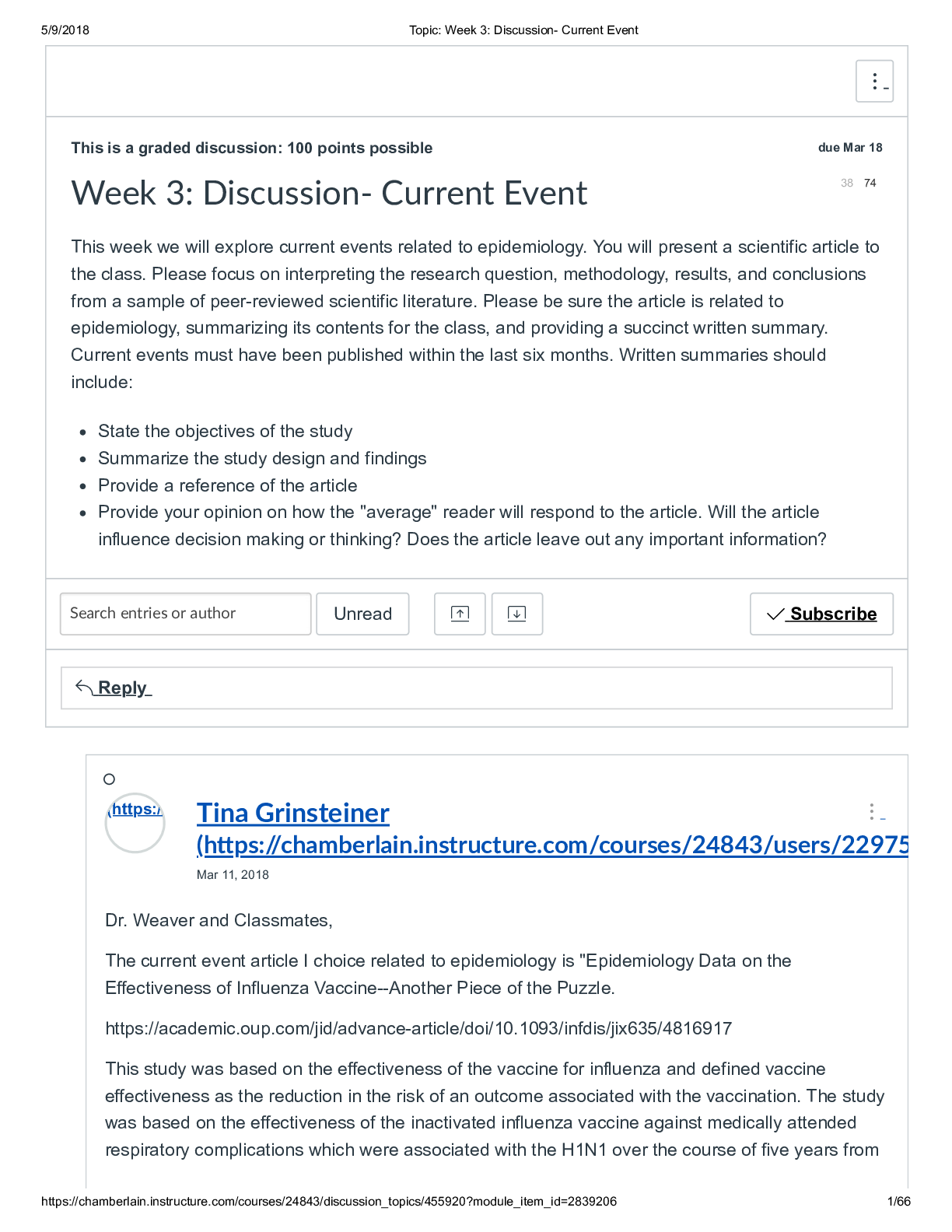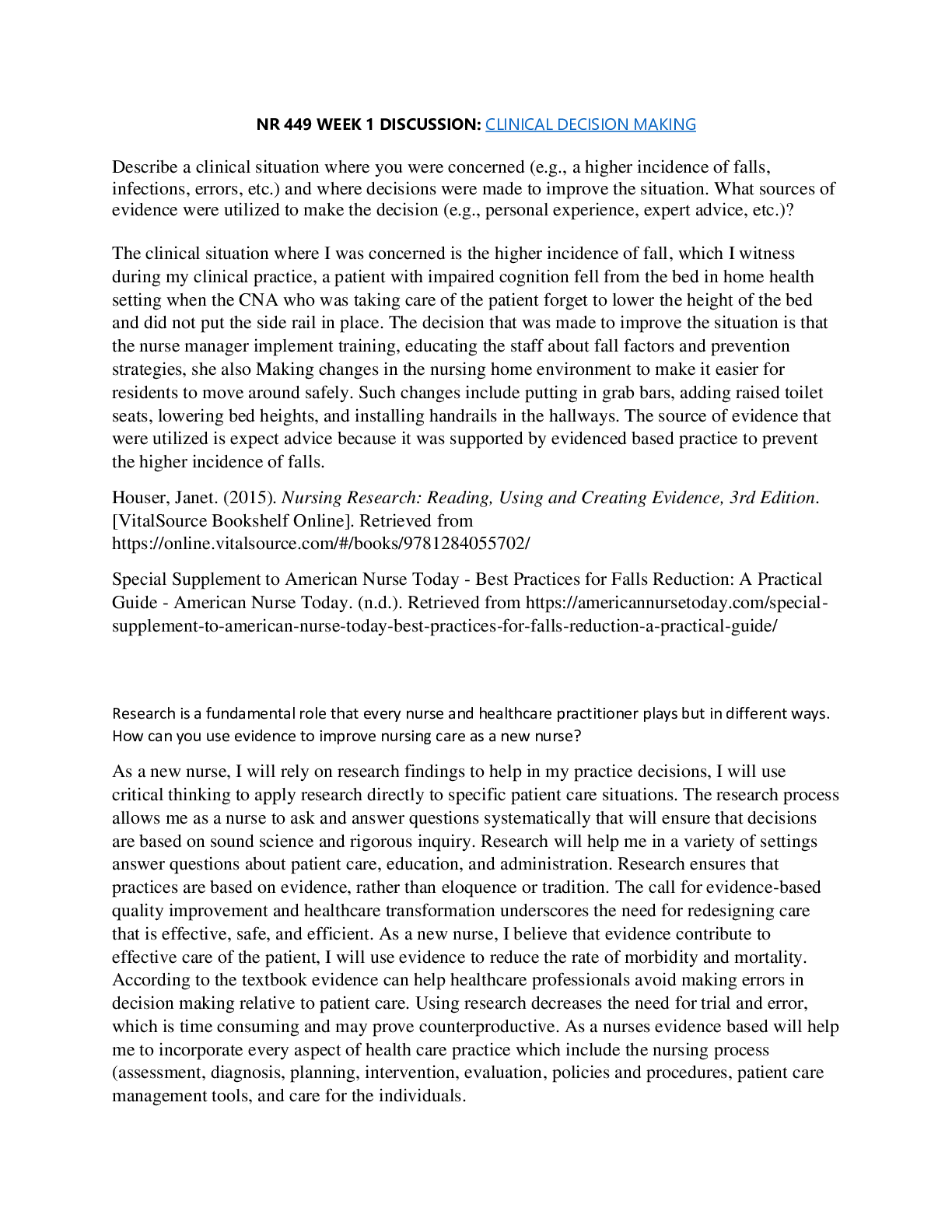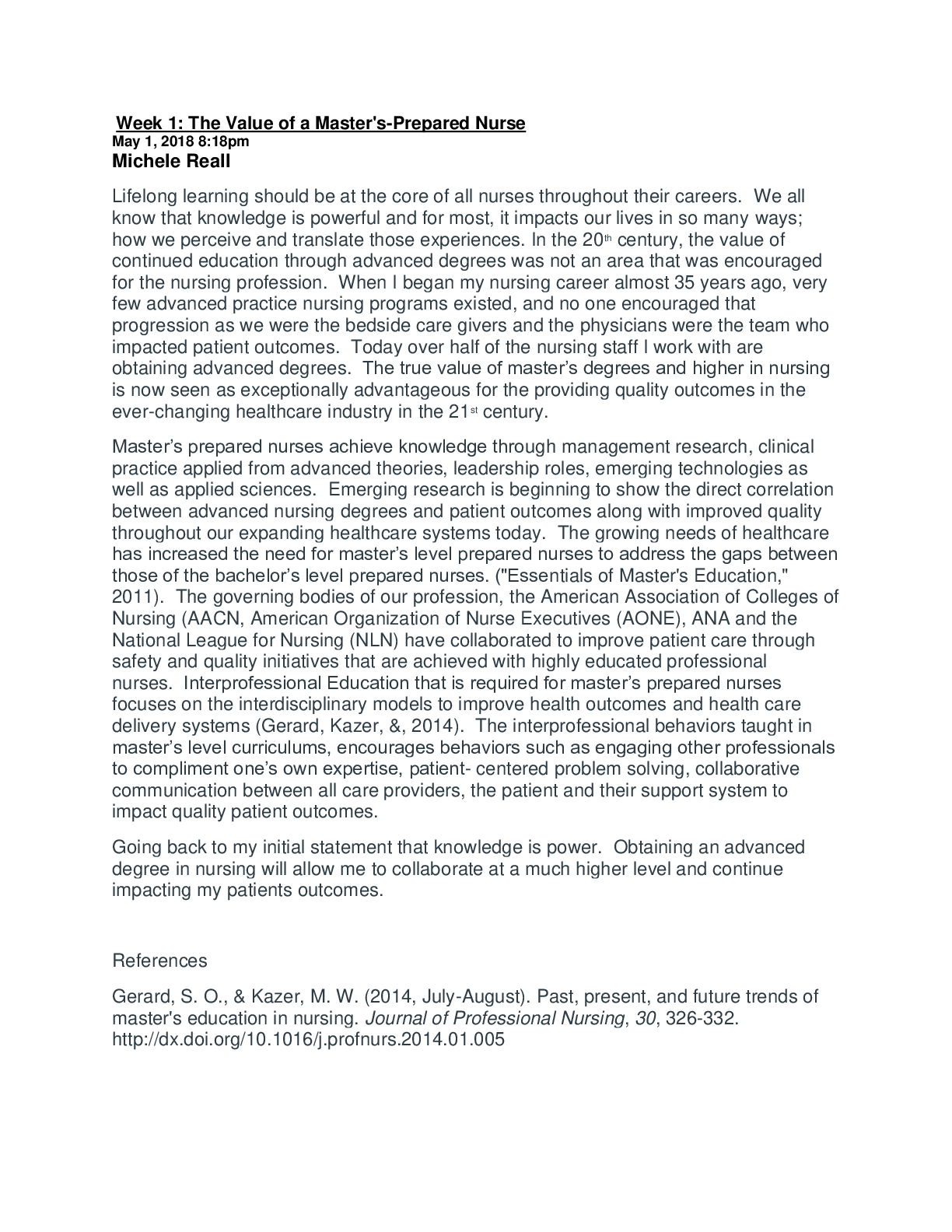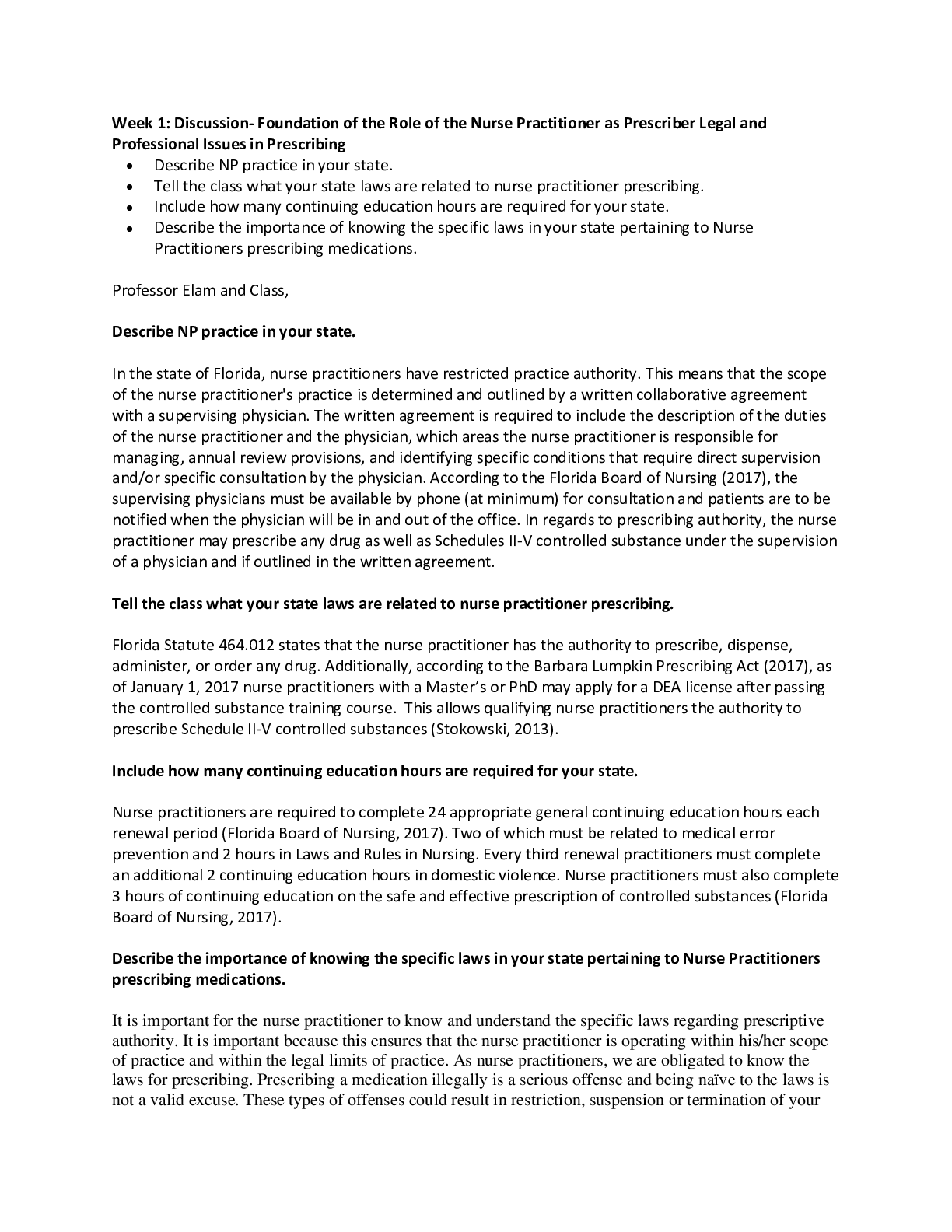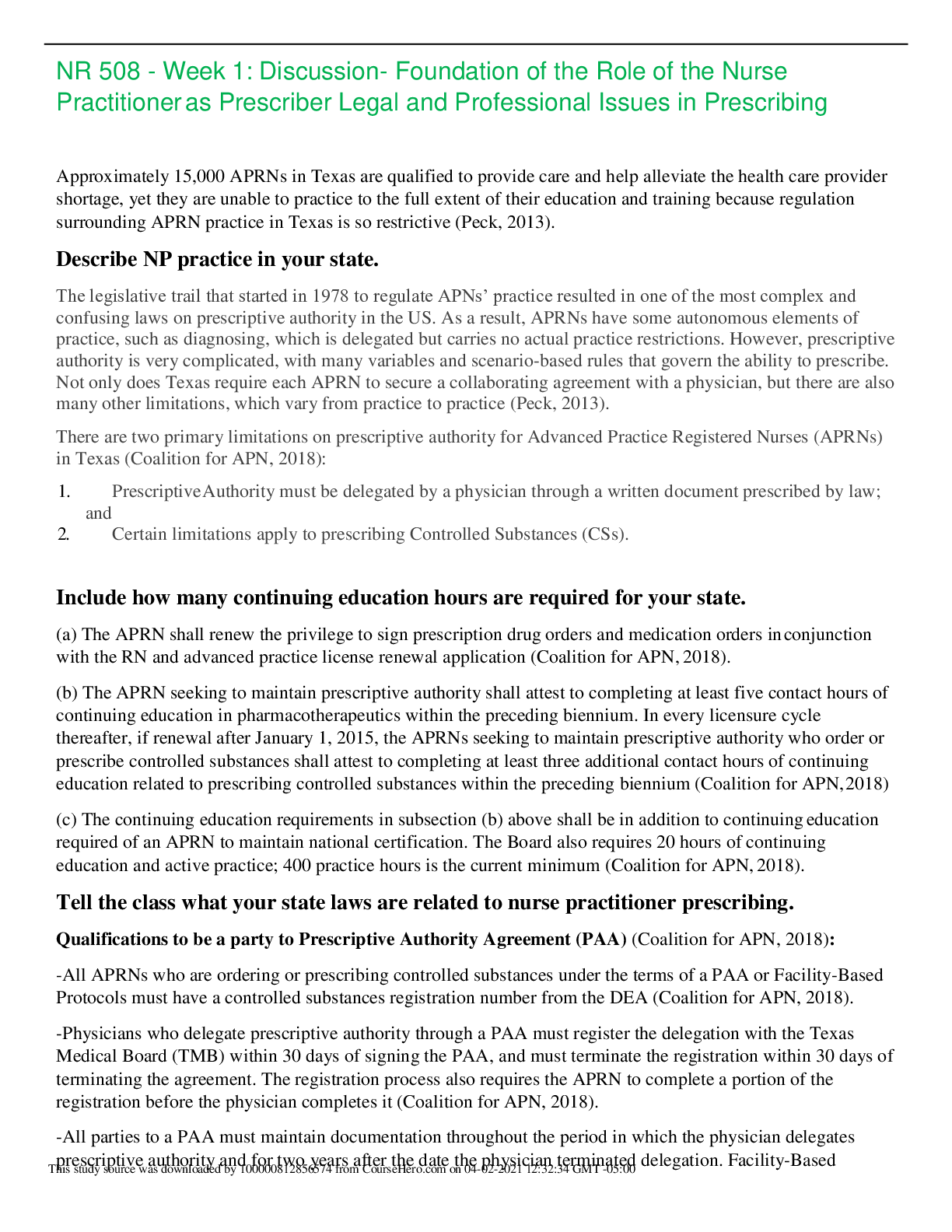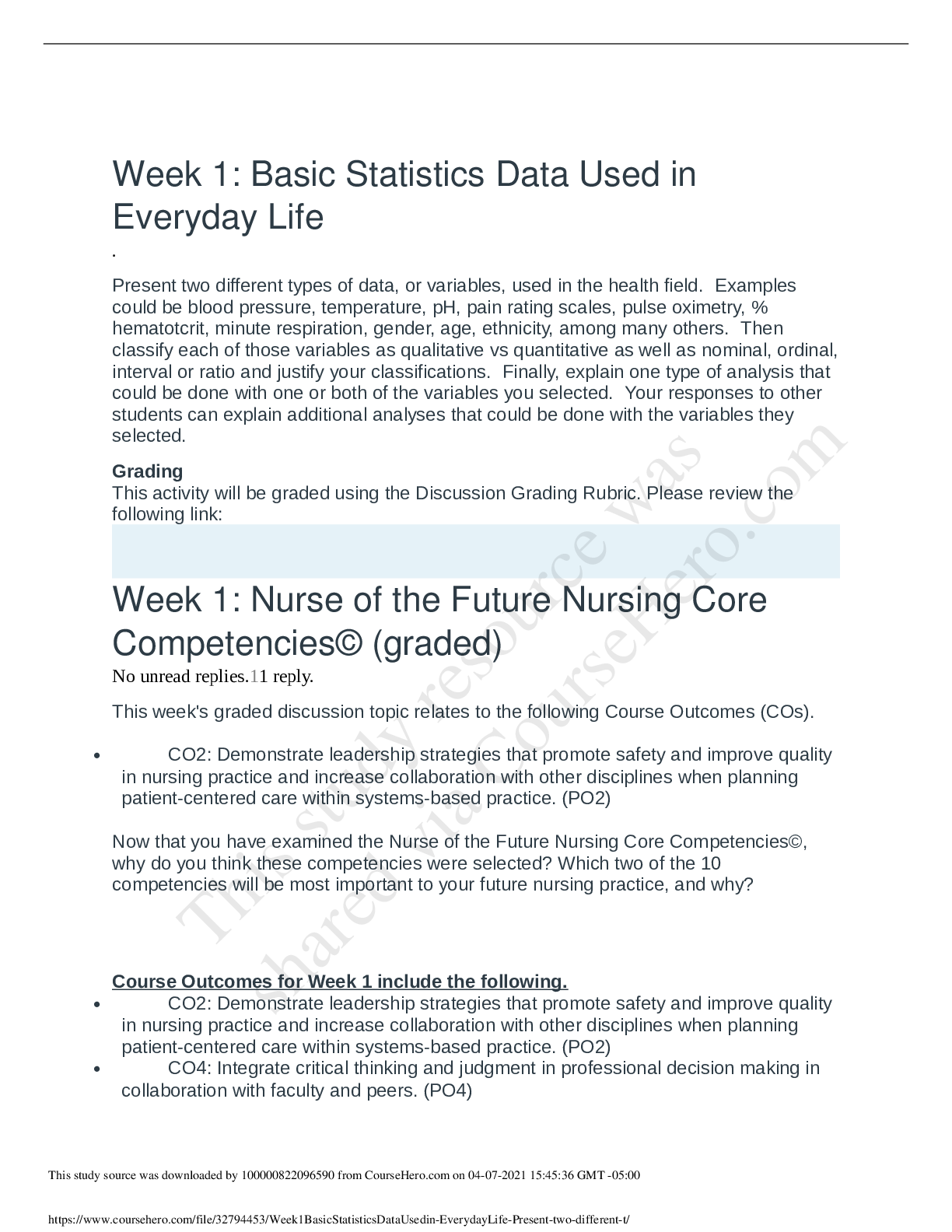*NURSING > DISCUSSION POST > NR 506 Week 1 Discussion: Barriers to Practice (Original Post, Responses)_Download To Score An A) (All)
NR 506 Week 1 Discussion: Barriers to Practice (Original Post, Responses)_Download To Score An A)
Document Content and Description Below
Identify and describe practice barriers for APNs in your state and discuss these barriers on a state and national level. In 2010 the Institute of Medicine (IOM) released the report, “The Future of... Nursing: Leading Change, Advancing Health advocating for an expanded scope of practice for APN’s (IOM, 2011). The role of Advanced Nurse Practitioners (APN) has expanded over the years and has become one of todays most sought after healthcare professions. However, despite the many advancements in the role of APN’s, there are still many barriers at the state and national level, hindering APN’s ability to practice to the full extent of their license. In 2015 the IOM reviewed the progress made after release of The Future of Nursing report upon which many barriers were discovered. Some of the barriers to expansion of APN’s scope of practice include, opposition by physicians and physician organizations, regulatory restrictions on nursing practice, lack of diversity in the nursing workforce, lack of data collection on nursing workforce, and lack of doctorate-trained nurses (IOM, 2015). Michigan is one of the 12 restrictive states which is making it difficult for APN to practice to the fullest extent of their education and training (Hain & Fleck, 2015). According to the IOM report (2011), overly restrictive scope-of-practice regulations in some states is one of the most serious barriers to accessible care (IOM, 2011). Restrictive practice prevents APN from engaging in at least one element of NP practice and requires supervision, delegation, or team management by an outside health discipline to provide patient care (AANP, 2016). APN’s in the state of Michigan can prescribe nonscheduled drugs but require oversight by physicians to prescribe schedule 2 through 5 drugs. Furthermore, a practice barrier for APN’s at a national level is physician and NP integration. APN have an important role in healthcare and can help meet the growing demand from primary care however, this some physician related barriers have made this difficult. For instance, some physicians believe that nurse practitioners lack competence to provide quality care (Hain & Fleck, 2015). Lack of knowledge on scope and knowledge of APN by physicians and healthcare providers is identified as a main contributor for this misconception (Hain & Fleck, 2015). It is important that physicians overcome this obstacle and APN come together and collaborate to achieve improved patient outcomes. 2. Identify forms of competition on the state and national level that interfere with APN’s ability to practice independently. In addition to barriers, APN have competition on state and national levels that interfere with their ability to practice independently. Being a restrictive practice state, Michigan physician supervision requirements cause competition that interferes with APN’s practicing ability (IOM, 2015). These restrictions have undermined the nursing profession’s ability to provide and improve both general and advanced care (IOM, 2011). Furthermore, APN’s are not recognized in Michigan state policy as primary care providers and therefore, not paid according to the services they provide (Hain & Fleck, 2015). Therefore, APN’s do not get paid as much as physicians do for performing the same services. 3. Identify the lawmakers at the state level (i.e., key members of the state’s legislative branch and executive branch of government) Lawmaking is in the purview of the US legislative branch of government. Once law is enacted by the legislative branch of government, the executive branch is responsible for implementing the laws. The national organization responsible for all APN’s in the United States (US) is the American This study source was downloaded by 100000831988016 from CourseHero.com on 04-18-2022 13:40:41 GMT -05:00 https://www.coursehero.com/file/57260964/nr506-week-1docx/ Association of Nurse Practitioners (AANP) and the law makers for the state of Michigan is the Michigan Council of Nurse Practitioners (MCNP) (AANP, 2019). Some of Michigan lawmakers include, current senators Gary Peters and Debbie Stabenow; speaker of the house, Nancy Palowski; Gretchen Whitmer, Governor of Michigan, Jocelyn Benson, Secretary of State, Lee Chatfield, Speaker of the House of Representatives, Mike Shirkey, Michigan’s senate majority leader, Senator Peter Lucido Chairperson of the Joint Committee on Administrative Rules (JCAR), Matt Maddock is the alternate Chairperson and Rebecca Fotsch, the director, state advocacy and legislative affairs National Council of State Boards of Nursing (NCSBN). 4. Discuss interest groups that exist at the state and national levels that influence APN policy. APN policy is influenced at both the state and national levels. The house of congress force compromise and bring about new legislation. The American Nurses Association (ANA) monitors federal agencies as they issue regulations and implementation of federal laws and lobby Congress and executive agencies and offer information that empowers nurses to share their perspective and expertise directly with policymakers (ANA, 2019). The ANA State Government affairs also tracks trends in nursing related legislation in the states (ANA, 2019). Lastly, the Administrative Procedure Act (APA) governs the process by which federal agencies develop and issue regulations (EPA, 2018). The Michigan Public Health Code defines the practice of nursing in Michigan and empowers the Board to establish qualifications for nurse licensure (MBN, 2019). The Bureau of Professional Licensing (BPL) is responsible for Michigan licensing and regulations. The administrative rulemaking process is overseen by The Michigan Office of Administrative Hearings and Rules (MOAHR) under the Department of Licensing and Regulatory Affairs. 5. Discuss methods used to influence change in policy in forms of competition, state legislative and executive branches of government and interest groups. There are many available methods that can be used to influence change in policy in forms of competition, state legislative and executive branches of government and interest groups. APN’s can influence change through advocacy, policy, lifelong learning and philanthropy (Burke, 2016). Through policy work, APN can influence practice standards and processes to assure quality of care and help shape the care that’s provided tomorrow. The Administrative Procedures Act (APA) provides opportunity for citizen review and input throughout the process of developing regulations (EPA, 2018). The Federal Trade Commission’s (FTC) protect consumers and enforce anti-trust legislation. They engage in competition advocacy for APRNs scope of practice in many states, providing letters, comments, and/or testimony (FTC, 2018). References American Association of Nurse Practitioners (AANP). (2016). State practice environment. Retrieved from https://www.aanp.org/legislation-regulation/state-legislation/state-practiceenvironment. This study source was downloaded by 100000831988016 from CourseHero.com on 04-18-2022 13:40:41 GMT -05:00 https://www.coursehero.com/file/57260964/nr506-week-1docx/ American Association of Nurse Practitioners (AANP). (2019). About AANPCB. Retrieved from https://www.aanpcert.org/about American Nurses Association (ANA). (2019). Federal Issues. Retrieved from https://www.nursingworld.org/practice-policy/advocacy/federal/ Burke, S. (2016). Influence through policy: Nurses have a unique role. Reflections on Nursing Leadership. Retrieved from https://www.reflectionsonnursingleadership.org/commentary/morecommentary/Vol42_2_nurses-have-a-unique-role Federal Trade Commission (FTC). (2018). The Antitrust Laws. Retrieved from https://www.ftc.gov/tips-advice/competition-guidance/guide-antitrust-laws/antitrust-laws Hain, D., Fleck, L., (2015) "Barriers to Nurse Practitioner Practice that Impact Healthcare Redesign" OJIN: The Online Journal of Issues in Nursing, 19. Retrieved from https://www.ncbi.nlm.nih.gov/pubmed/26824837 Institute of Medicine (IOM). (2011). The future of nursing: Leading the change, advancing health. Washington, D.C.: The National Academies Press Institute of Medicine (IOM). (2015). Assessing Progress on the Institute of Medicine Report The Future of Nursing. Retrieved from https://jonasphilanthropies.org/wpcontent/uploads/2017/10/Assessing-Progress-on-the-Institute-of-Medicine-Report-The-Futureof-Nursing_Dec2015.pdf Michigan Board of Nursing, (MBN). (2019). Administrative Rules. Retrieved from https://www.michigan.gov/whitmer/0,9309,7-387-90501_90626-250441--,00.html United States Environmental Protection Agency, (EPA). (2018). Laws & Regulations. [Show More]
Last updated: 2 years ago
Preview 1 out of 3 pages
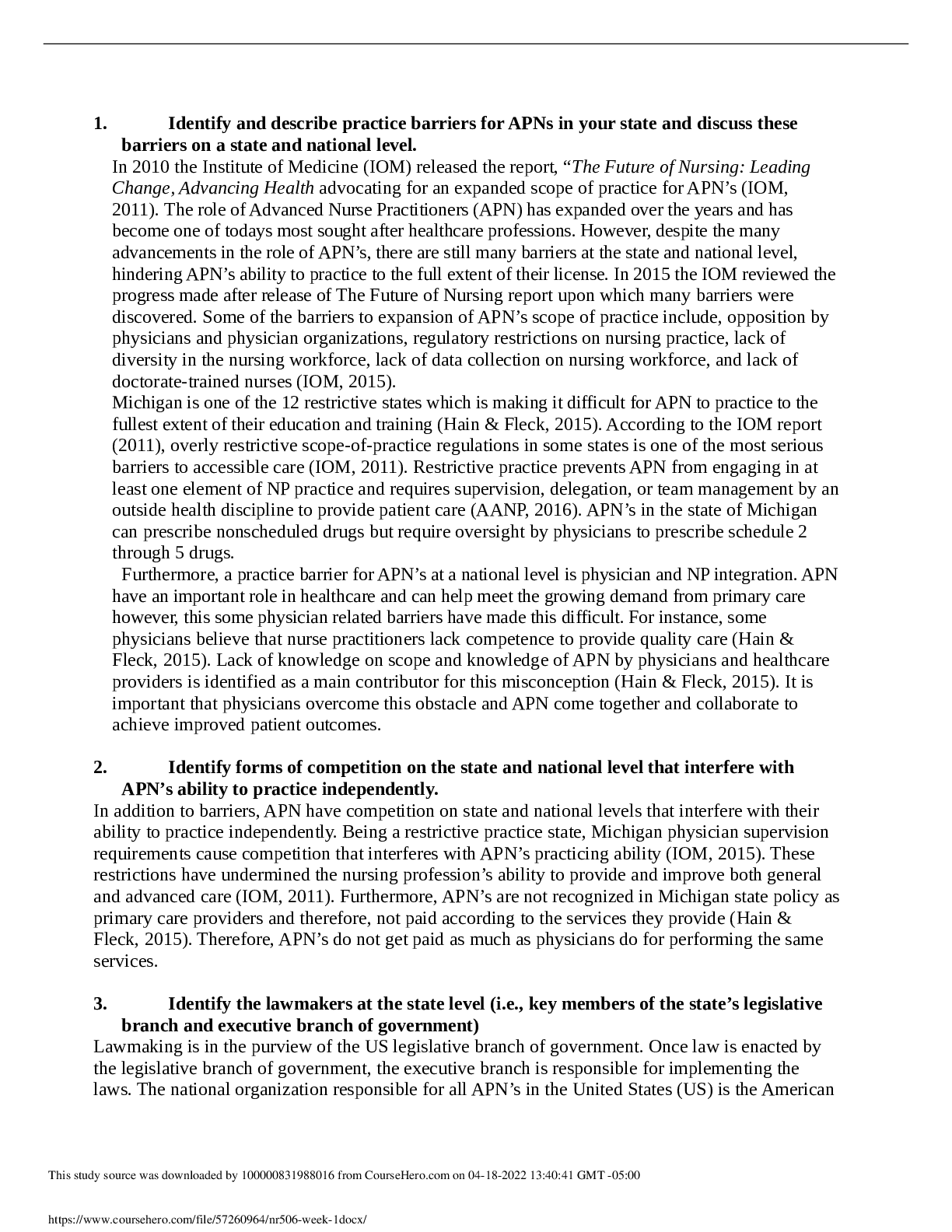
Buy this document to get the full access instantly
Instant Download Access after purchase
Buy NowInstant download
We Accept:

Reviews( 0 )
$11.00
Can't find what you want? Try our AI powered Search
Document information
Connected school, study & course
About the document
Uploaded On
Apr 18, 2022
Number of pages
3
Written in
Additional information
This document has been written for:
Uploaded
Apr 18, 2022
Downloads
0
Views
158

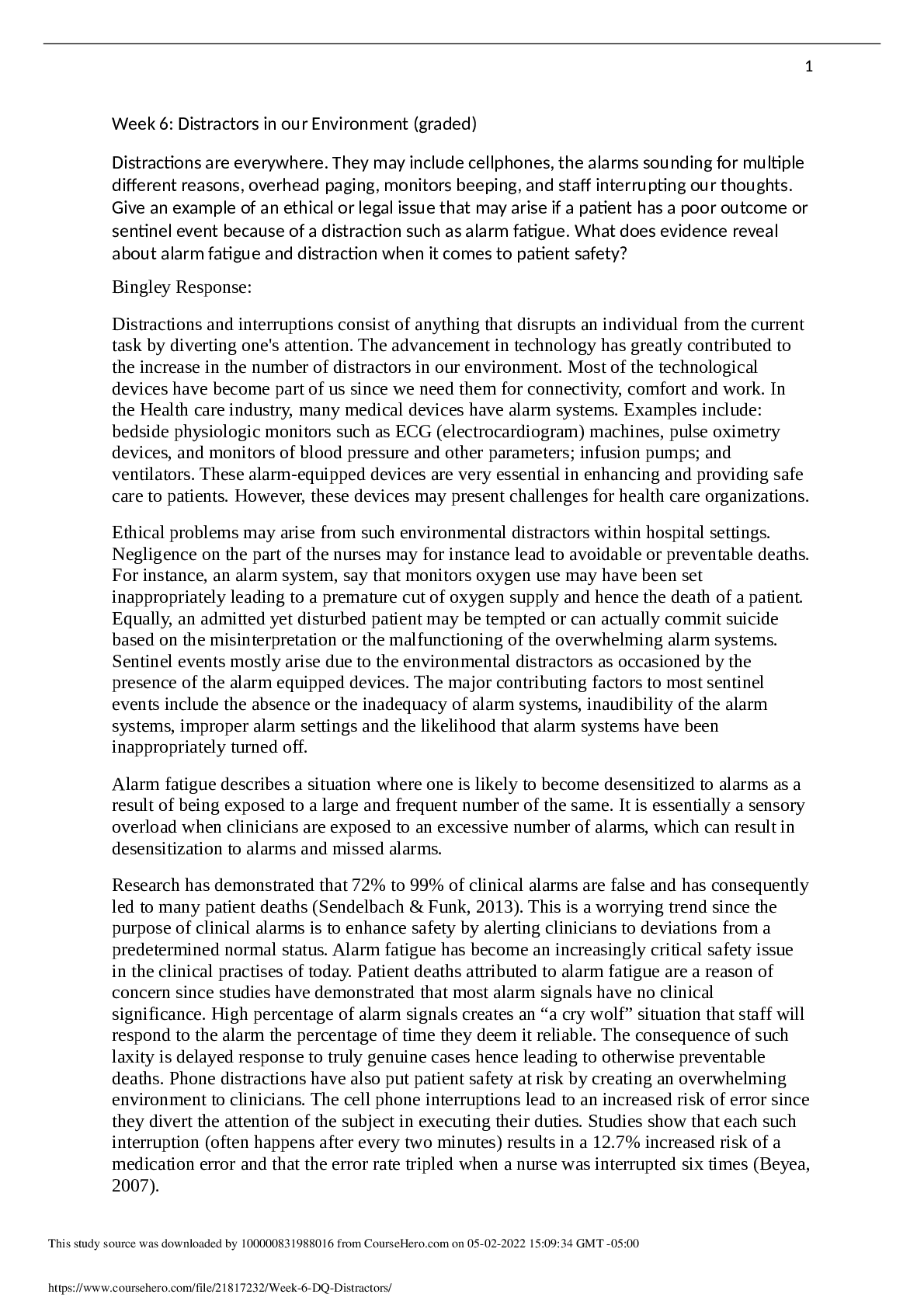
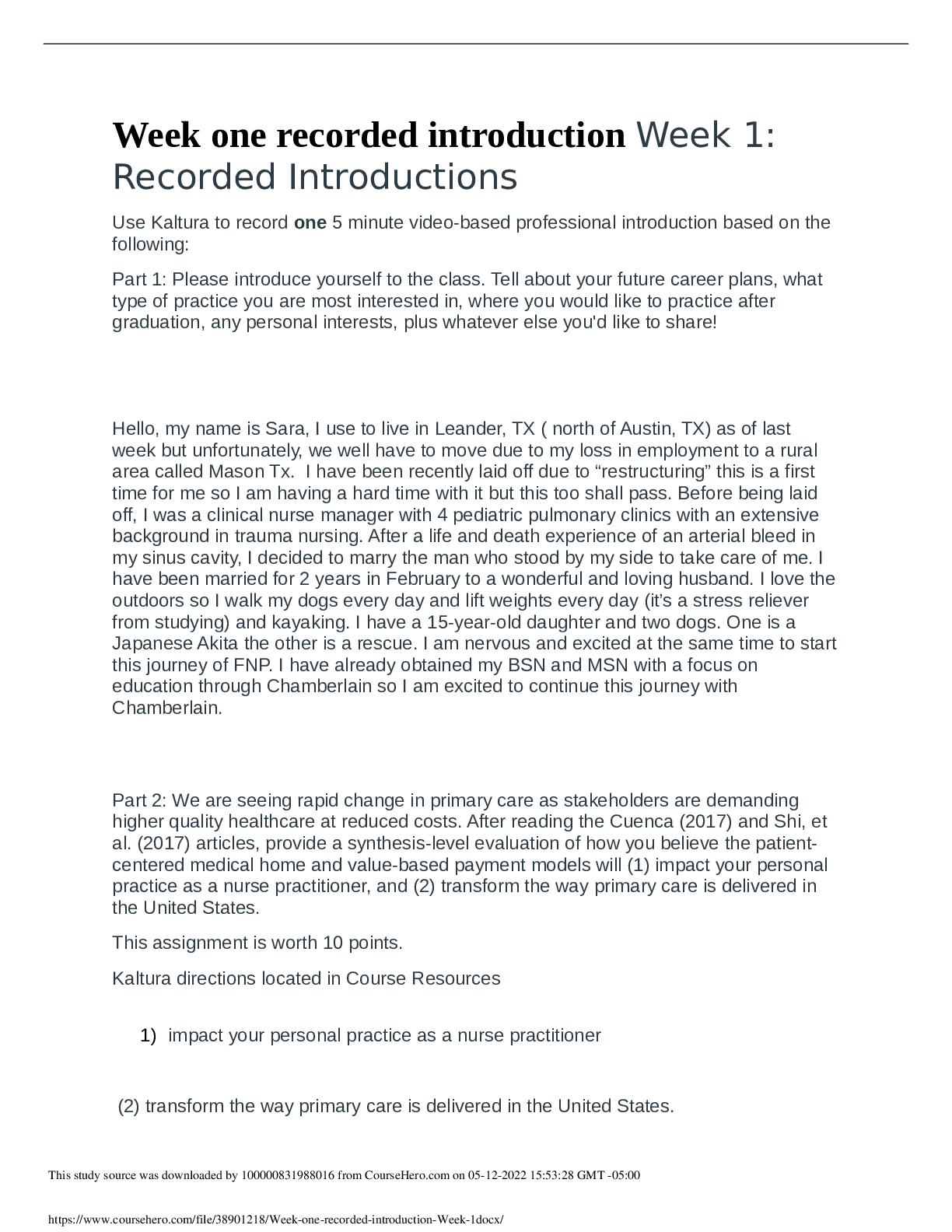


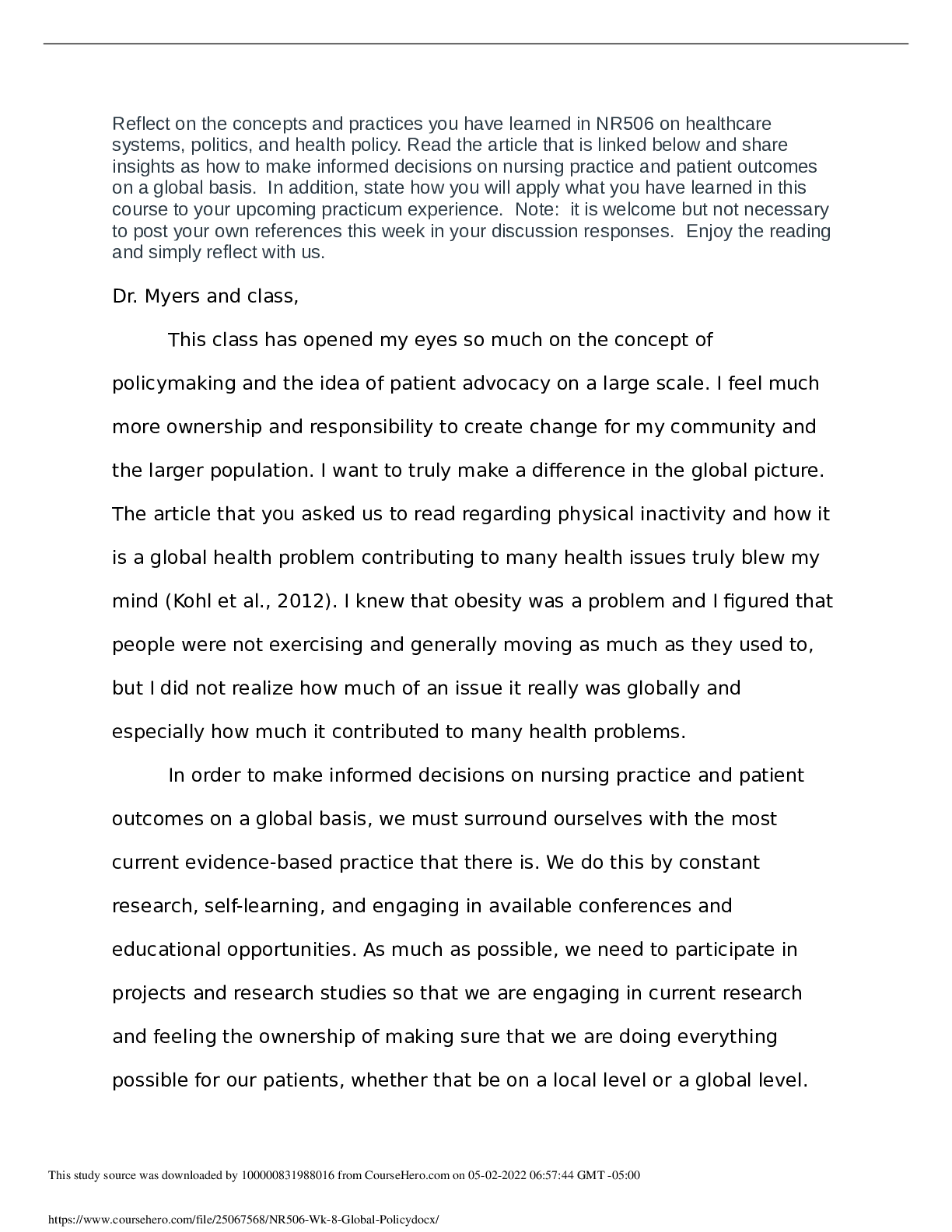
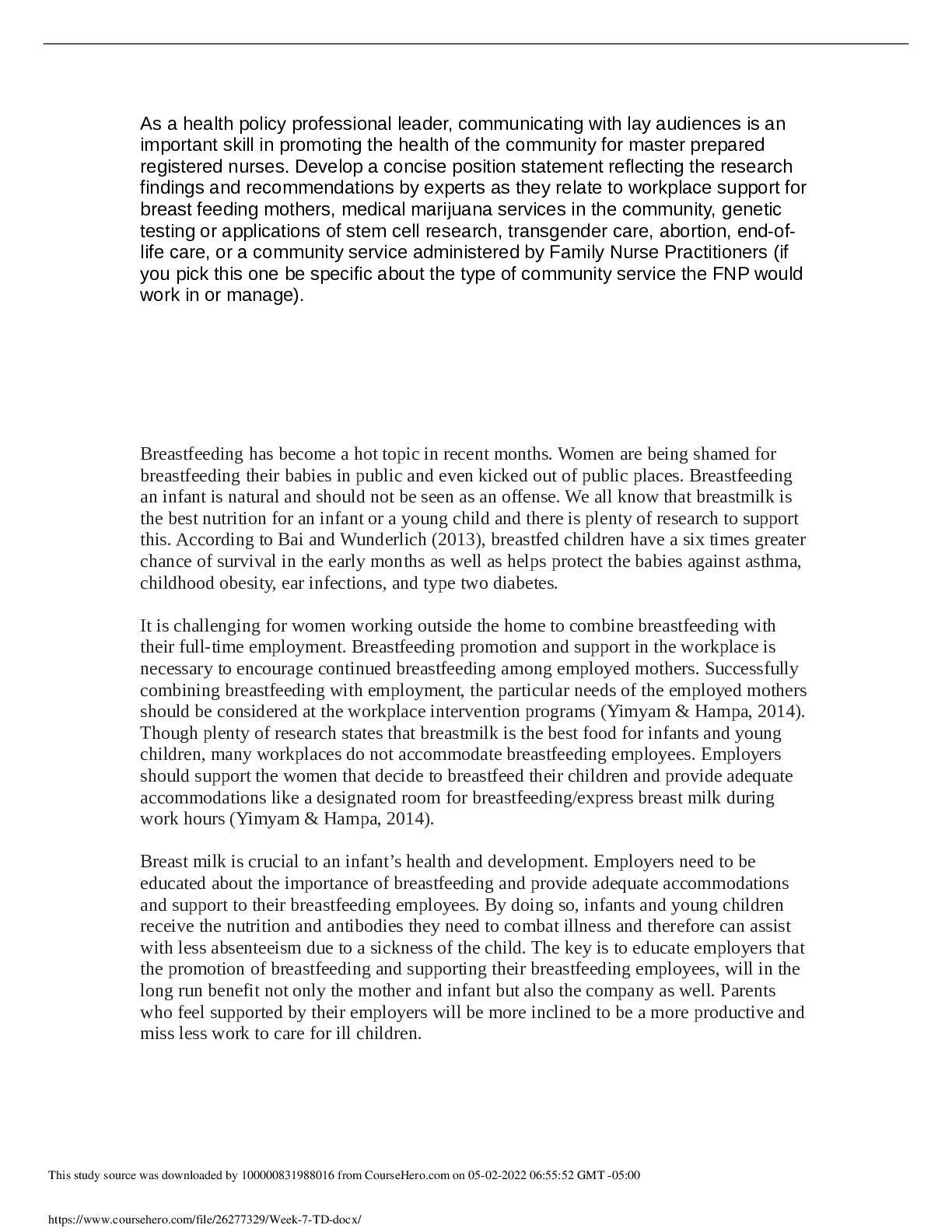
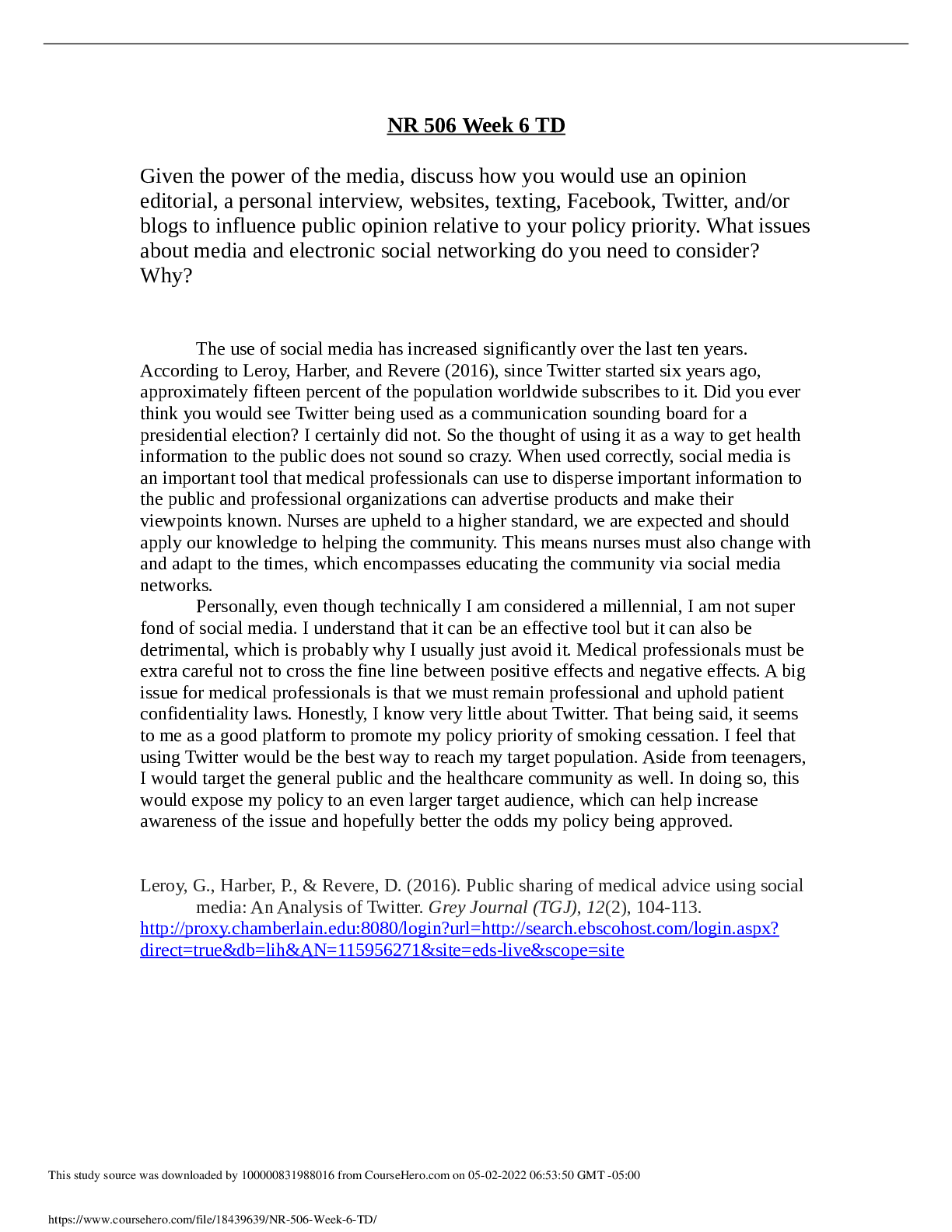
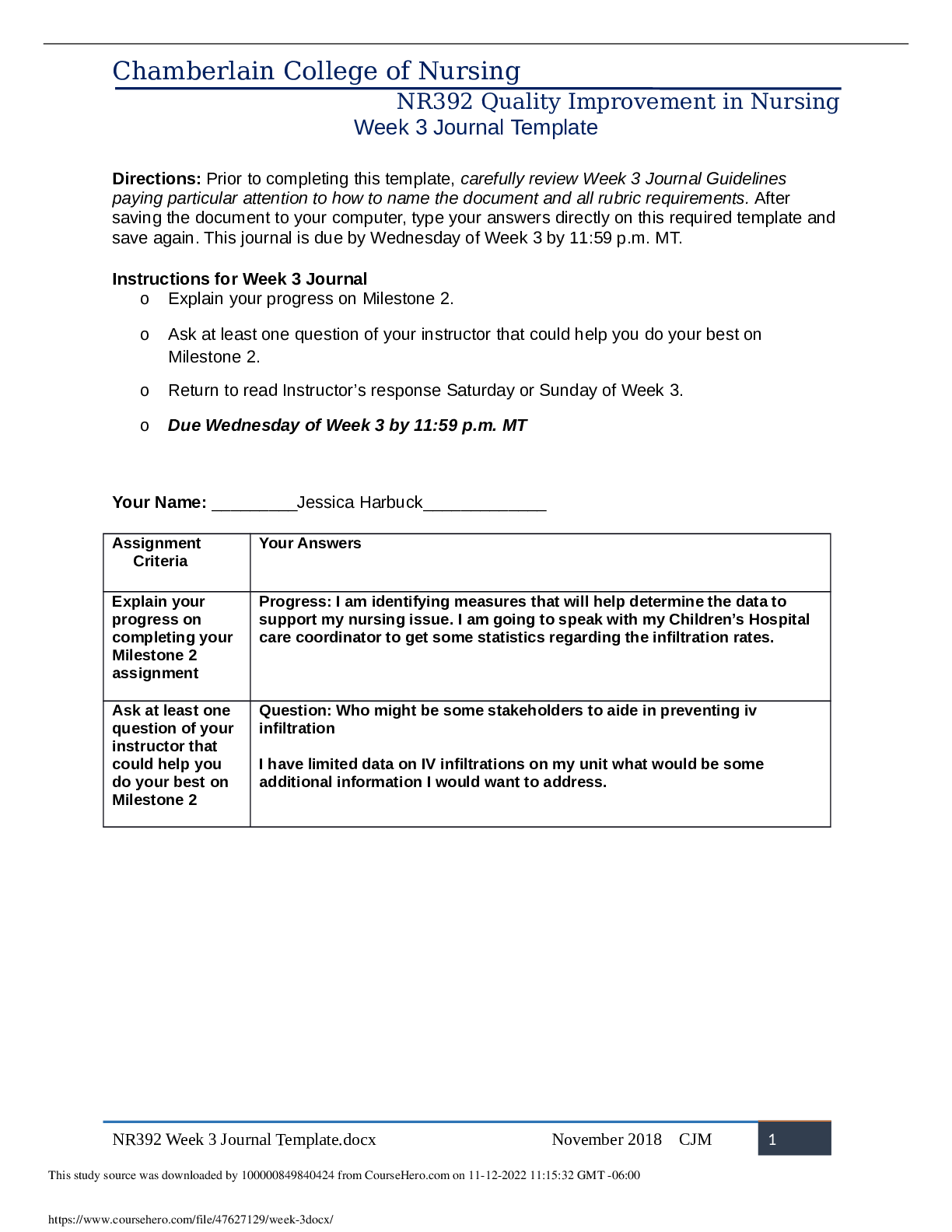
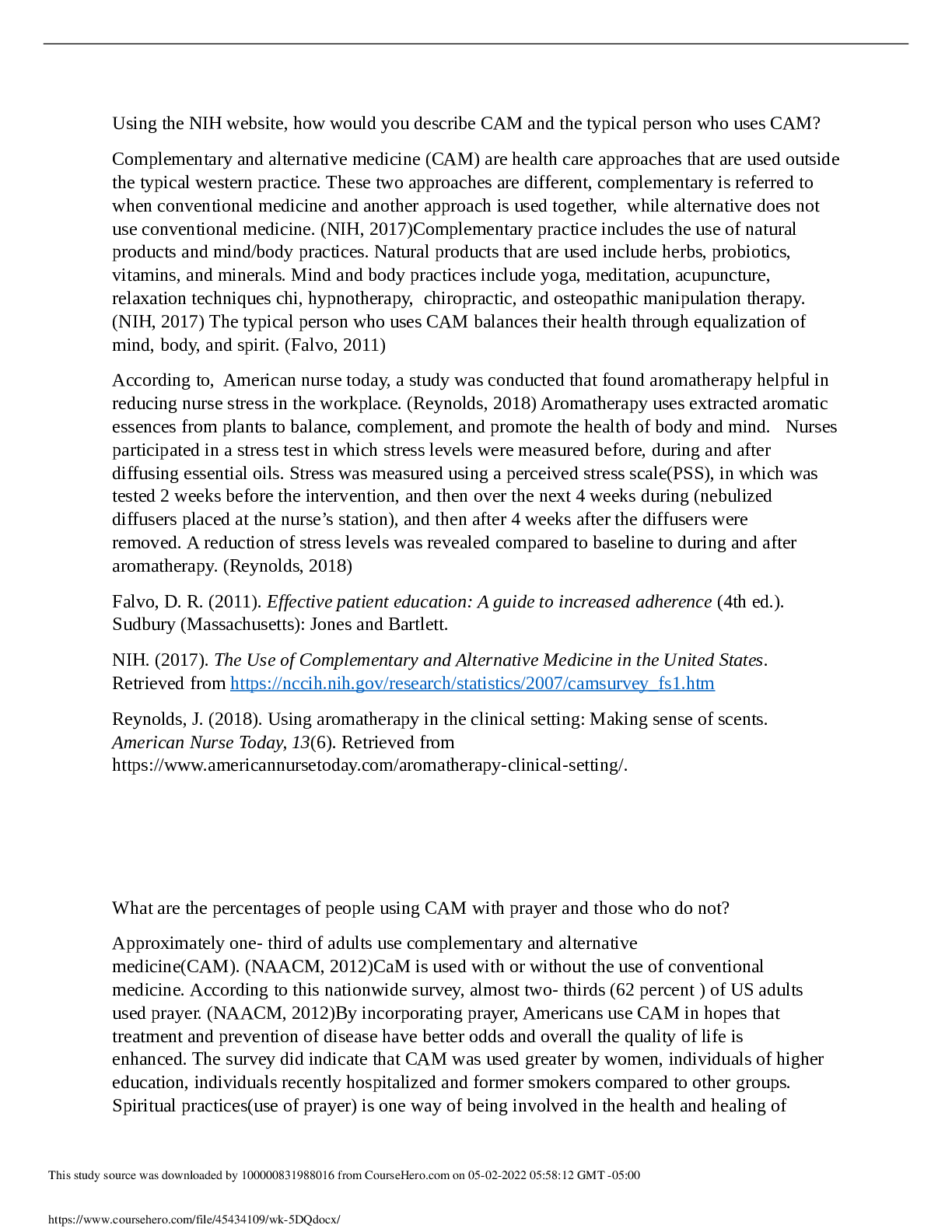
.png)

